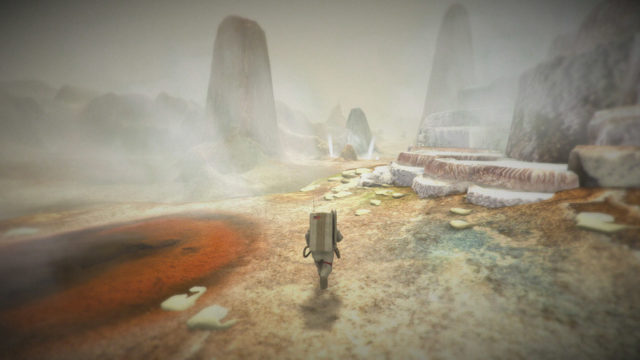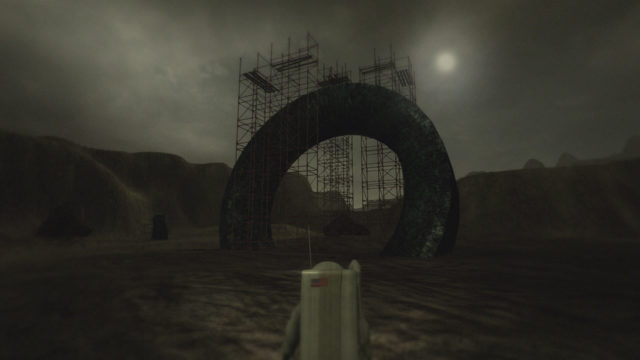Interesting sci-fi story; great art direction; fantastic soundtrack.
Blocky character models and some weak textures; gameplay might be too simple for some; floaty jumping.
Science fiction games tend to lean heavily in one of two directions, action or horror; either you’re a badass marine with an arsenal of high tech weaponry or you’re a normal person caught up in some nightmare scenario in a setting where no one can hear you scream. While Lifeless Planet occasionally borrows a little bit from the latter take, it’s mostly an effort at creating a hard science fiction adventure driven by story as well as a sense of discovery. These are ambitious goals, especially for a project largely made by one developer, and you can see the strain of limited resources, but ultimately we’re left with an exceptionally intriguing game.
The game kicks off with your character, an unnamed astronaut, experiencing a rough landing on a mysterious planet far from earth. Your fellow crew members are gone and you are low on oxygen so you set off with the goal of trying to survive and figuring out what is happening on this strange new world. Since this is a story driven game, I don’t want to go into too much detail, but it doesn’t take too long for you to realize this planet isn’t as lifeless as the title might suggest. People have been here before and something happened that has left the planet in a dire situation, and figuring out exactly what happened might be your only way of getting home. The story itself stumbles a little bit with its over-reliance on various log and journal entries, but the twists and turns are generally compelling, as is the use of environmental storytelling throughout. The end doesn’t quite match the build-up throughout the game, but it’s far from any sort of major disappointment and the game’s relatively short running time actually feels perfect for the story being told.

In terms of gameplay, Lifeless Planet progresses in a fairly linear fashion, only occasionally opening up to wider areas that encourage broader exploration. Generally though, you are led along through various challenges based around platforming and/or puzzle solving. None of these mechanics present a great deal of challenge, but they change up frequently enough that they rarely feel tiresome or bland. That being said, there is a lot of walking fairly long distances of oftentimes barren terrain that could easily bore some. Frustration might also pop up from time to time thanks to some floaty jumping controls that can make some platforming sections feel harder than they actually are. Overall, this focus on simplicity feels like it mostly benefits the game because the focus remains on progressing through the story.
Of course, telling a story in a video game can benefit from a great visual presentation and this is where Lifeless Planet is definitely a mixed bag. On the one hand, much of the game looks like it largely could have been accomplished on an N64; textures and geometry are often very simple and a general lack of variety in some areas can make stretches of the game really uninteresting to look at. Or at least that’s the case early on, because as the game progresses the art direction really starts to shine through and we see some great use of lighting and fog. Some areas in the game are absolutely breathtaking despite the lack of advanced graphics and these parts left a much bigger impression than the barren wastelands you occasionally traverse. Some cut-scenes also suffer from the simple visual style, but once again, the direction largely makes the blocky character models a moot point. Also, it’s worth noting that I did experience occasional slow-downs and stutters, though they never severely impacted gameplay or the overall experience.

The sound design, on the other hand, is almost without fault. The sound effects are actually fairly sparse and simple, but it really works considering the isolating nature of much of the game. The soundtrack is really what shines the most, though. Much of the game, especially early on, is quite purposefully silent with music only coming in at the right moments to add emphasis to new discoveries or significant story beats. As the game progresses and the tension increases, the music becomes more common and evolves appropriately as sparse atmospheric sounds give way to progressively bigger, more driving songs that would feel at home in any of the best sci-fi games or movies. The game also features a few voice acted roles and the performances, while not necessarily award-worthy, are quite solid and sell the emotion they’re trying to convey.
Without delving into major plot details, that’s really all there is to say about Lifeless Planet; it’s a simple game trying to tell an ambitious story and it mostly succeeds despite some very noticeable limitations, both in terms of technology and design. For some, the gameplay might prove too simple and the comparatively low fidelity visuals might pull people out of the experience and distract them from what the game does well. While part of me would definitely love to see Lifeless Planet re-imagined with a more modern engine and an extra layer or two to the gameplay, I can’t deny I found the game plenty compelling as it is. So, for those interested in a no-frills, story driven sci-fi adventure that doesn’t overstay its welcome, Lifeless Planet is well worth a closer look.
Nintendojo was provided a copy of this game for review by a third party, though that does not affect our recommendation. For every review, Nintendojo uses a standard criteria.




 ShareThis
ShareThis





